Sticky Note Questions
Before I left for Antarctica, I asked my students to write down questions they had for me on sticky notes. I brought those sticky notes with me to the South Pole and started looking for answers. Here’s are 10 of the most commonly asked questions and the answers I’ve found out:
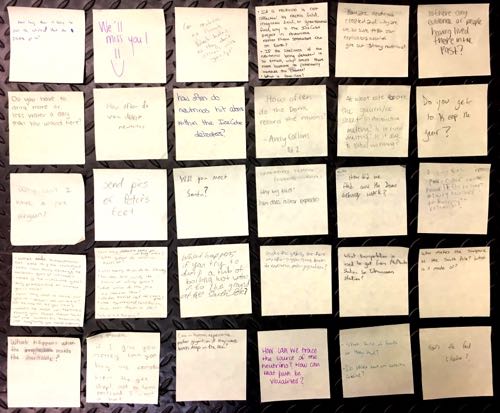 Sticky notes full of questions from my students.
Sticky notes full of questions from my students.
1. What type of food is there at the South Pole?
The food here is absolutely awesome, thanks to our amazing kitchen staff. Lead chef Bryan, more commonly called “Big Country,” does a great job creating tasty and creative dishes.
Each day, the menu is different. Here’s this week’s menu:
 Each day's lunch and dinner menu varies, but it's always tasty!
Each day's lunch and dinner menu varies, but it's always tasty!
There’s also a freezer full of leftovers just in case you miss mealtime. Additionally, there’s always self-serve ice cream, cookies, hot chocolate and tea.
Remember that all food needs to be flown in, which makes cooking challenging because flight cancellations are common. We get really excited when “freshies” (fresh fruit) are served – it’s considered a delicacy here.
2. What does Antarctica look like under all the ice?
If you were to remove all of the ice on Antarctica, you’d find a continent with some interesting terrain.
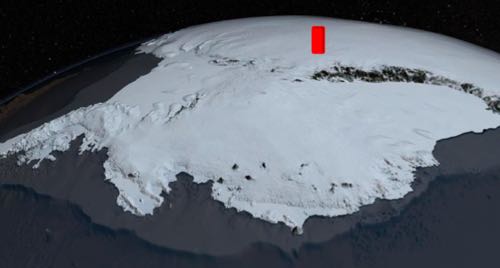 The continent of Antarctica covered in ice. The red marker shows the South Pole. (Credit: National Science Foundation)
The continent of Antarctica covered in ice. The red marker shows the South Pole. (Credit: National Science Foundation)
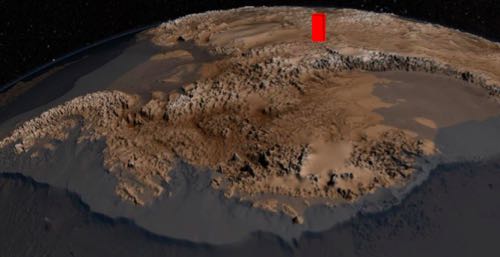 What Antarctica would look like if all the ice were removed. The red marker shows the South Pole. (Credit: National Science Foundation)
What Antarctica would look like if all the ice were removed. The red marker shows the South Pole. (Credit: National Science Foundation)
The Transantarctic Mountains split Antarctica into two main ice sheets – the West Antarctic Ice Sheet and the East Antarctic Ice Sheet.
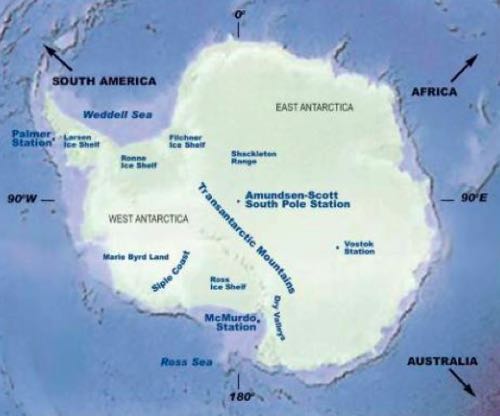 Notice how the Transantarctic mountains divide East Antarctica from West Antarctica. (Credit: National Science Foundation)
Notice how the Transantarctic mountains divide East Antarctica from West Antarctica. (Credit: National Science Foundation)
These mountains stretch almost 2200 miles all the way across the continent, making it one of the longest mountain ranges on Earth. The tallest mountain in this range is almost 14,800 ft high!
 See how the Transantarctic mountains separate the East Antarctic Ice Sheet from the West Antarctic Ice Sheet? (Credit: National Science Foundation)
See how the Transantarctic mountains separate the East Antarctic Ice Sheet from the West Antarctic Ice Sheet? (Credit: National Science Foundation)
The South Pole Station (where I’m at) sits atop several hills as well as the East Antarctic Ice Sheet. We’re at about 9300ft, which makes altitude sickness a concern the first few days after we arrive.
What happens to all the objects that need to be trashed or recycled?
According to the Antarctic Treaty, all garbage including trash, recycling, hazardous materials, food waste, etc. (everything but human waste) must be flown off the continent. For this reason, we’re really careful here to do our part in creating less waste – take one napkin instead of two, eat all the food you take, and properly sort waste into the right bin.
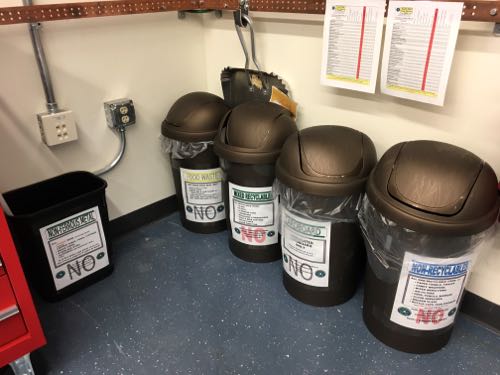 Here are the many bins at the IceCube Lab to sort our waste into.
Here are the many bins at the IceCube Lab to sort our waste into.
So what happens to human waste? Well, in order to get water for the station, ice underground is melted. After melting, we’re left with a big hole. We fill that hole with human waste, which gets frozen in place never to be recovered. Gross, huh?
3. If I put a piece of bread on the North and South Pole, would I have an Earth Sandwich?
Yes. Yes you do.
4. If 1 trillion neutrinos pass through us every second, isn’t it extremely likely that at least a few hundred will hit an atom every few seconds or so?
Great question! Yes, there are about 1 trillion neutrinos passing through your body every second. Most of those neutrinos are coming from our sun and have fairly low energies. IceCube is not built to observe these low-energy solar neutrinos. At these low energies, not a lot of light is produced. Because the DOMs of IceCube are spread out (about 55ft from one another), the array of DOMs just isn’t dense enough to pick up this faint light.
So that leaves us with high-energy neutrinos. Although their sources (things like active galactic nuclei, supernovae, etc.) are thought to produce lots of neutrinos, these neutrinos have to travel incredible distances through space and just happen to hit Earth, specifically within the IceCube detector so we can see it. IceCube is big (~1km^3), but relatively it’s not that big.
Finally, the likelihood of a neutrino interacting with the nucleus of an atom is verrrrry small. Like unbelievably small. Probability just isn’t on our side. So in the end, we’re pretty happy with the 55 total (about one per month) high-energy neutrinos that we have detected with IceCube so far!
5. How much does each DOM cost?
Each DOM costs about $5000. Now multiply that by over 5000 DOMS in IceCube and you get more than $25 million in the cost of DOMs alone!
Overall, IceCube has received about $250 million from the United States, with supplemental money from European countries. This is so much money that it needed Congressional approval!
6. The polar bear is the only animal on earth that will actively hunt and eat humans.
Well this isn’t exactly a question and I’m not sure about the validity of this statement. But I would like to clear something up – there are NO polar bears in Antarctica. Polar bears live in the Arctic (the other side of the world).
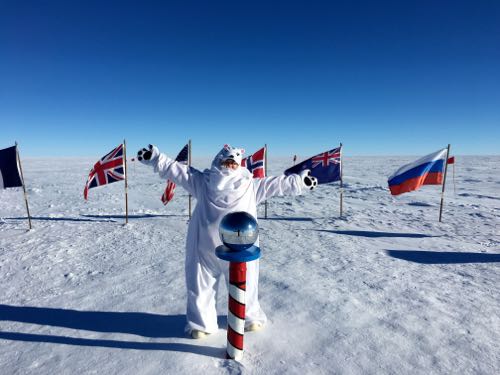 There are NO Polar Bears in Antarctica, except for maybe this one.
There are NO Polar Bears in Antarctica, except for maybe this one.
In fact, there’s no wildlife at all at the South Pole – it’s just too cold and there is no food source. However, at McMurdo near the coast, you can see skua (a type of bird), seals, and penguins if you’re lucky.
 Although I didn't get to see this first hand, Martin was able to capture this shot of seals laying on the ice, penguins waddling by, and a skua flying in the air at McMurdo. (Credit: NSF/Martin Wolf)
Although I didn't get to see this first hand, Martin was able to capture this shot of seals laying on the ice, penguins waddling by, and a skua flying in the air at McMurdo. (Credit: NSF/Martin Wolf)
7. What do people do in their free time?
There are so many activities here at the South Pole Station – Sunday Morning Cartoons (BYOMAC – bring your own milk and cereal), Monday night Game Night in the Galley, movies in the lounge, Sunday Science Talks, pool in the Game Room, the Sauna, the music room, yoga, running at the gym…the list goes on and on.
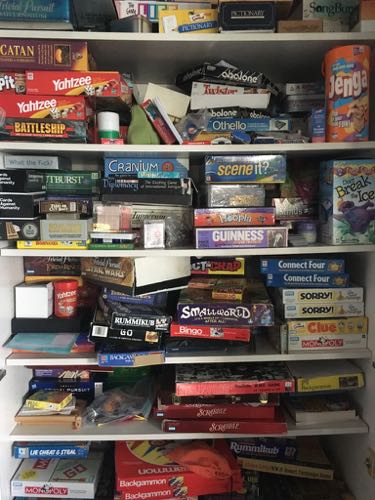 One of three shelves full of games in the Game Room at the South Pole.
One of three shelves full of games in the Game Room at the South Pole.
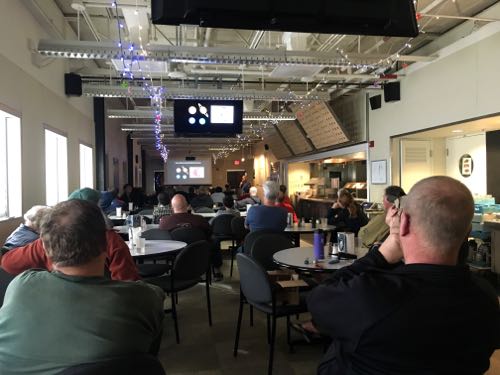 Everyone gathers in the Galley to listen to the Sunday Science talk on the Solar Telescope. Each week a new experiment is featured.
Everyone gathers in the Galley to listen to the Sunday Science talk on the Solar Telescope. Each week a new experiment is featured.
It almost feels like summer camp – there’s always something fun going on to keep us entertained once our work is done.
8. Why would you not be able to detect neutrinos in places warmer than Antarctica?
IceCube isn’t at the South Pole because of the cold temperatures. There are three main reasons we’re here:
- IceCube detects the blue light that comes from a neutrino hitting an atom. In order to detect that light well, we need a lot of a really clear substance (known as a “medium”) for the light to travel through. With a clear medium, light won’t take weird bends or curves as it travels so we can trace it back to where that neutrino came from. The South Pole has the clearest ice in the world, making it a prime location. Other experiments use different mediums for their detector, such as the experiment known as Antares that uses the Mediterranean waters.
- Because we’re at the South Pole, Earth acts as a giant filter for other particles besides neutrinos. For example, if a cosmic ray were to strike the Earth’s atmosphere over the North Pole, a bunch of particles (some neutrinos, many not) would shower down. As those particles travel from the North Pole through the Earth to the South Pole, the non-neutrino particles get filtered out. So if we detect a neutrino coming from below in the IceCube detector, we’re pretty confident it’s a neutrino. Other experiments, such as Super Kamiokande, are built in mines inside of mountains so that the mountain itself acts as a filter.
- There’s a lot of great ice all over Antarctica, but IceCube is built next to the Amundsen-Scott South Pole Station because it provides essential support. Everything from the machinery to build and maintain IceCube, to medical staff back at the station, and of course a warm place to eat, drink, and sleep nearby. We wouldn’t be able to do the awesome science we do without the firefighters, cooks, machinists, doctors, dishwashers, the people who run the power plant, the people who run the heavy equipment…the list goes on and on.
So we can (and scientists are) detecting neutrinos in other places around the world!
9. How much power does the station use every day?
This I did not know. So I talked to Jim and Weeks, two guys who work at the Power Plant here. Here’s what I learned:
- The average power load is ~550-600kW
- ~17000kWhr of power was used last week
- ~$1 million per month is spent on fuel for the generators (this does not include maintenance, parts, or anything else!)
- ~1200-1300 gallons of fuel are used per day
- The cost is ~$35 per gallon (compared to ~$3 per gallon for your car)
- The heat waste from the generators is used to heat the building! This works in the winter too, so the boiler is rarely fired up
- Three buildings have solar panels on them and there are a few wind turbines. But the primary power source remains jet fuel.
10. What do you expect to discover? How will the results of this experiment help the world?
We don’t quite know what we’re going to discover. This is real research happening in real time, and the great thing about research is that we don’t know the answers yet.
We’re driven by a curiosity about our own universe. What can we find when we look at the universe in a new and different way? What can one of the tiniest particles tell us about the most violent events in our universe?
One approach is to use the results from IceCube to do “Multi-Messenger Astronomy.” Let’s say IceCube detects a neutrino and can trace is back to a certain spot in the sky. We know something interesting must be happening there to have produced this neutrino! So we point our x-ray telescope and our radio wave telescope and all of our different telescopes at that point to try to learn more about it.
We’re not quite sure how the results can or will benefit humanity. But there have been many examples throughout history where scientific research yielded surprising results that greatly benefited humanity. For example, Alexander Fleming was studying the influenza virus when he left for a two-week vacation. When he came back, a mold had contaminated his influenza sample and had strangely killed all the bacteria. This mold was basis for the invention of penicillin, and modern medicine hasn’t been the same since. Who would’ve thought that’s where Fleming’s research would lead?
Personally, I believe that what makes us human is to be curious about where we’ve come from, what’s happening now, and where we’re going next. Neutrino research can help us better understand our own universe, the place we call home.
More questions? I’ve got answers.
I’m only scratching the surface of the sticky note questions my students wrote down, selecting the 10 of the most commonly asked questions for this journal. There are so many great questions and so little time…
If I didn’t answer your question, please post a comment below. I’ll be sure to get back to you with an answer!


Comments
Add new comment